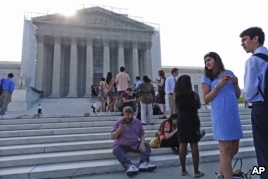(单词翻译:单击)
听力文本
From VOA Learning English, this is the Education Report.
Reaction appears mixed to a recent United States Supreme Court decision on affirmative action in university admissions. Affirmative action in admissions means that schools give special consideration to some racial or ethnic minorities. The goal is to create a more diverse campus, and to give more opportunities to groups that are under-represented in higher education.
The Supreme Court ruled that race can be one of many factors considered when a student applies to a college or university. The court said education benefits from having diverse student populations.
People line up in front of the Supreme Court in Washington, Jun. 24, 2013, before it opened for its last scheduled session.
Some legal experts expressed surprise at the decision. They thought the justices would strike down a 2003 Supreme Court ruling. That ruling let universities use race in admissions decisions, but also said race needs to be just one factor among others.
In the new decision, the justices did not deal with the question of affirmative action itself, as many observers had expected. The court did not decide whether the idea violates the right of equal protection under the law, as guaranteed by the constitution. Instead, the justices sent the case back to a lower court for further consideration.
A white woman who had been denied admission to the University of Texas at Austin brought the legal case. Abigail Fisher argued that it was wrong to reject her, when minority students with similar grades and test scores were accepted because of affirmative action.
Wade Henderson is president of the Leadership Conference on Civil and Human Rights. He said the new decision reconfirms that it is an America's interest to increase opportunities for everyone.
Justice Clarence Thomas, the only African-American on the Supreme Court, voted with the majority but wrote a separate opinion. His opinion strongly attacked affirmative action in college admissions as violating the constitution. He also said that the diversity by itself does not have any educational benefit.
Ada Meloy is general counsel for the non-profit American Council on Education.
"...that the colleges and universities should have the right to decide upon who will be admitted to the institution. And those that feel they need to consider race or ethnicity and make that decision should be able to do so, in line with the law that has been proclaimed by the Supreme Court since the 1970's."
She said it was not clear how many of the 4,000 or so higher learning institutions in the United States use those criteria in deciding which student to accept. Ms. Meloy said many of the schools do not generally give special consideration to their applicants' race or ethnicity.
And that's the Education Report from VOA Learning English. I'm Karen Leggett.
文本为51VOA听写整理
译文属可可原创,仅供学习交流使用,未经许可请勿转载
词汇解释
1.affirmative action 肯定行动,平权行动
Voters in Michigan responded by approving a 2006 ballot measure that banned affirmative action.
于是,密歇根的选民通过了2006年投票办法禁止了平等权益措施.
2.strike down 杀死;击倒
Frank had been struck down by a massive heart attack.
弗兰克被严重的心脏病夺去了生命。
3.ethnicity n. 种族划分,种族
He said his ethnicity had not been important to him.
他说他的种族渊源对他向来都不重要。
参考译文
这里是美国之音慢速英语教育报道。
公众对最近美国最高法院在大学录取时实行平权法案的决定反应不一,招生平权法案意思是学校特别照顾一些少数种族或民族,其目的是创造更多样化的校园,给劣势群体更多接受高等教育的机会。
最高法院判定,在学生申请学院或大学时,种族可作为众多考虑因素之一。法院称学生群体多样化有利于教育发展。
有的法律专家对该决定表示吃惊,他们认为法官可能会推翻2003年的最高法院判决,该判决允许大学在招生时考虑种族,但种族只是诸多因素之一。
在新决定中,法官并没有处理平权法案本身,这与很多观察家的预料相符。法官并没有判定它是否违反根据宪法人人平等的权利。与此相反,法官将案子交到低级法院做进一步考虑。
被奥斯丁德克萨斯大学拒录的白人女子提交了这起案件,阿比盖尔·费舍尔称,分数差不多的少数学生因平权法案而获录用,这对自己不公平。
韦德·亨德森是民权和人权领导会议主席,他说新决定再次表示,为每个人提供更多机会符合美国的利益。
法官拉伦斯·托马斯是最高法院中唯一的非裔美国人,他在投票时遵从多数人的意见,但写出了自己的看法。他言辞谴责高校招生的平权法案违宪,他说多样化本身对教育没有任何益处。
阿达·梅洛伊是非盈利组织美国教育委员会的总顾问。
“学院和大学应有权力决定谁被录取,有的学校感到有必要考虑族裔,并可以这么做,这符合20世纪70年代以来最高法院公布的法律。”
她说尚不清楚美国4000多所高校中有多少所在使用这个标准来录取学生,梅洛伊说很多学生一般不考虑申请人的种族。
这里是美国之音慢速英语教育报道,我是凯伦·莱格特。


